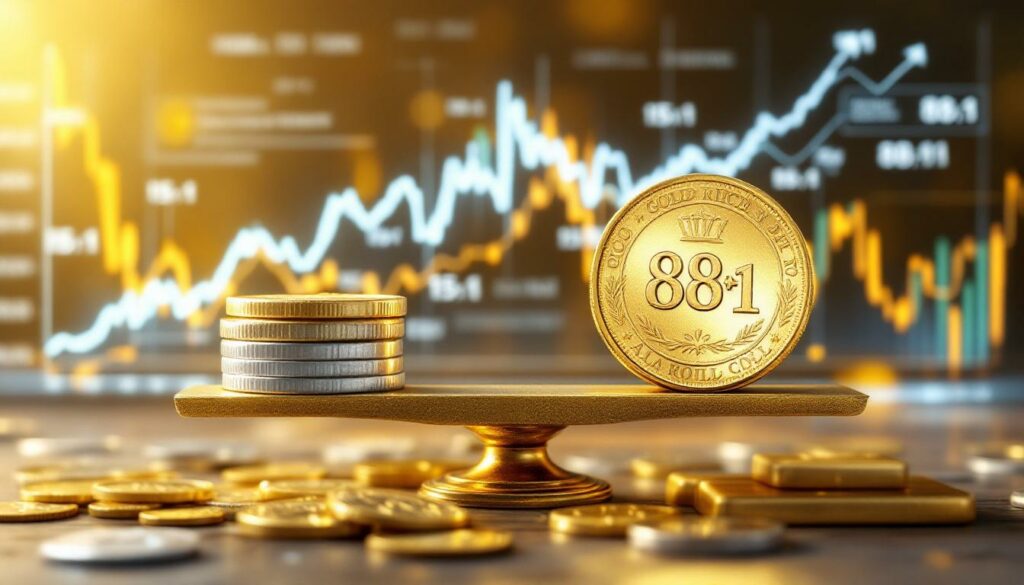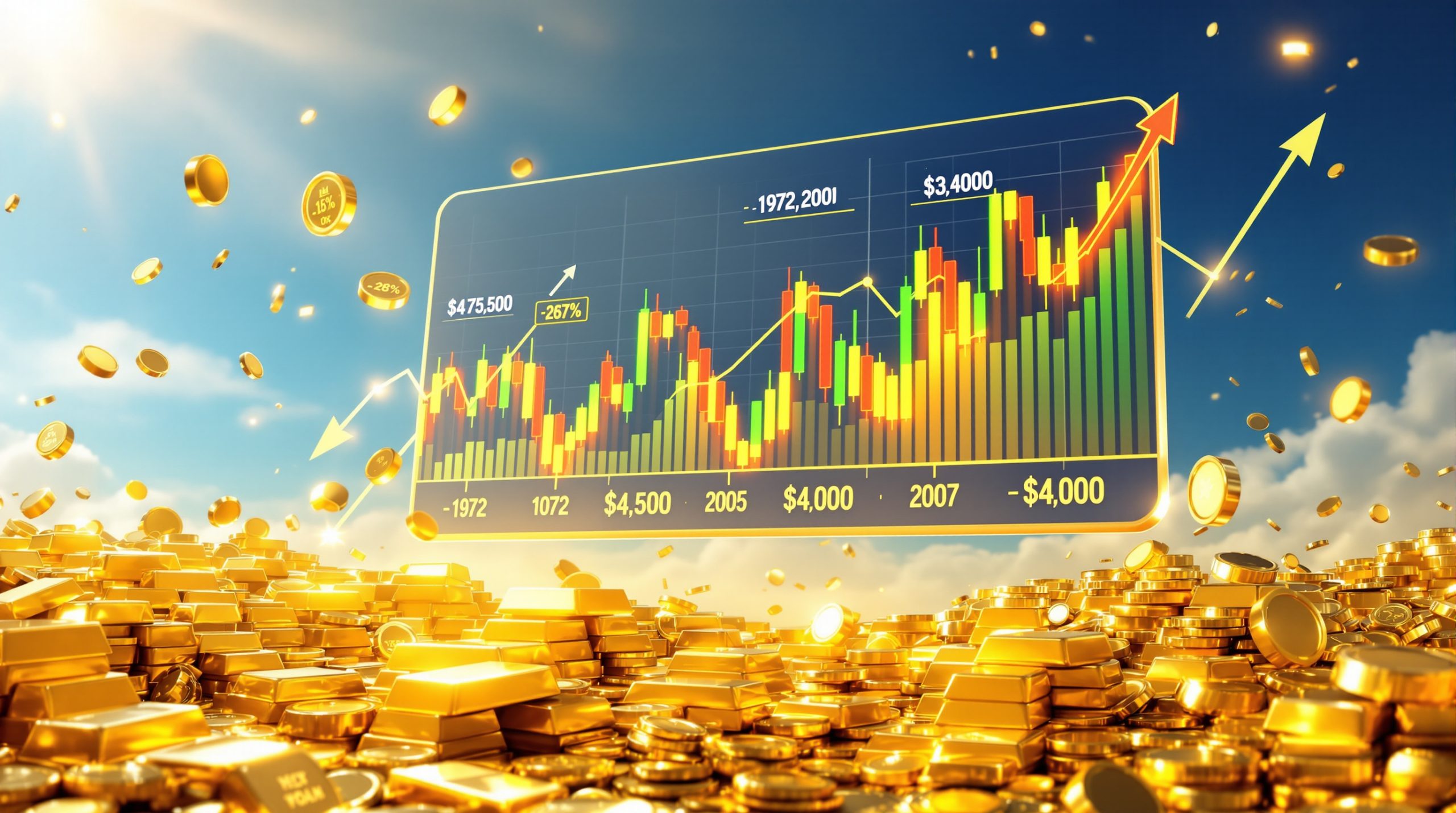Understanding the Gold to Silver Ratio: Historical Patterns and Investment Implications
The gold to silver ratio represents the amount of silver required to purchase one ounce of gold. This key metric has been used by investors for centuries to determine the relative value between these two precious metals and identify potential investment opportunities.
How the Ratio Is Calculated
The gold to silver ratio is calculated by dividing the current gold price by the current silver price:
Gold to Silver Ratio = Price of Gold per Ounce ÷ Price of Silver per Ounce
For example, if gold trades at $3,300 per ounce and silver at $40 per ounce, the gold to silver ratio would be 82.5:1, as noted by Jaime Carrasco, Portfolio Manager at Carrasco Wealth Management.
Current Ratio Context
As of mid-2024, the gold to silver ratio stands at approximately 88:1, meaning it takes 88 ounces of silver to purchase one ounce of gold. According to Carrasco, "The historical connection between the price has always been between 16 to 1 to 30 to 1. Here we are sitting at 88 to 1." This ratio sits significantly higher than historical norms, suggesting a potential imbalance in the relative valuations of these metals.
Why Is the Gold to Silver Ratio Important for Investors?
The gold to silver ratio serves as a crucial indicator for precious metals investors seeking to optimize their portfolio allocations and timing decisions.
Identifying Relative Value
When the ratio rises substantially above historical averages, it may indicate that silver is undervalued relative to gold. Conversely, when the ratio falls below historical norms, gold might be considered undervalued compared to silver.
Timing Metal Rotation Strategies
Sophisticated investors often use the ratio to guide their rotation between these metals:
- When the ratio is high: Consider increasing silver allocation
- When the ratio is low: Consider increasing gold allocation
This strategy is exemplified by Carrasco's approach: "I'm going to let my silver producers ride much higher until we get to at least a 40 to 1 gold silver ratio."
Signaling Broader Economic Trends
The ratio often reflects broader economic conditions:
- Rising ratio: May indicate economic uncertainty (flight to gold's safety)
- Falling ratio: May signal economic expansion (industrial demand for silver increases)
Carrasco suggests that market manipulation has contributed to the current imbalance: "That catchup has a lot to do with the obfuscation of the ability of the banking sector to mess around with the price and the emancipation of the price will sooner or later occur because it has to go back to balance."
Historical Perspective on the Gold to Silver Ratio
Understanding the historical context of this ratio provides valuable insights for interpreting its current levels.
Ancient and Pre-Modern Ratios
For thousands of years, the gold-silver ratio analysis maintained remarkable stability:
- Roman Empire: Approximately 12:1
- Middle Ages through 1700s: Typically ranged between 12:1 and 15:1
- 19th century: Generally fluctuated between 15:1 and 16:1
The 20th Century Shift
The abandonment of bimetallic and gold standards fundamentally altered the relationship:
- 1940s-1960s: Typically ranged from 20:1 to 40:1
- 1970s-1980s: Experienced extreme volatility, reaching as low as 16:1 during the 1980 silver price spike
- 1990s-2000s: Generally trended higher, averaging between 50:1 and 70:1
Recent Decades
The 21st century has seen unprecedented ratio levels:
- 2008 Financial Crisis: Spiked above 80:1
- 2020 Pandemic: Briefly exceeded 120:1 before retreating
- 2023-2024: Hovering around 85:1 to 90:1 despite record gold price trends
Why Does Production Not Match the Price Ratio?
One of the most intriguing aspects of the gold to silver ratio is how it diverges from the actual production ratio of these metals.
The Production Paradox
Global annual production figures reveal a striking disconnect according to Carrasco:
- Annual silver production: Approximately 900 million ounces
- Annual gold production: Approximately 130 million ounces
- Production ratio: Roughly 7:1 (silver to gold)
Yet the price ratio stands at 88:1—over 12 times higher than what production figures might suggest as "natural." As Carrasco emphasizes, "If you look at that price relationship on the actual production, it should be around 7 to 8:1 while we're sitting at 88 to 1."
Factors Behind the Disconnect
Several factors help explain this apparent paradox:
1. Industrial Consumption
Unlike gold, approximately 50% of silver production is consumed in industrial applications, effectively removing it from investment circulation. Carrasco highlights silver's industrial importance: "It's one of the most important industrial metals for electronics. And electronics are key component of the future world."
2. Banking Sector Influence
Financial institutions have significant influence in precious metals markets through:
- Paper contracts that may exceed physical metal backing
- Derivatives markets that can impact price discovery
- Historical interventions in precious metals markets
3. Monetary vs. Industrial Perception
Gold is primarily viewed as a monetary metal and store of value, while silver's dual role as both industrial and monetary metal creates more complex price dynamics.
4. Supply-Demand Imbalance
The silver market squeeze faces a structural deficit, with global demand exceeding mine production significantly. According to Carrasco, "We have a massive structural deficit in that we actually produce a third less a quarter to a third less silver than we than the global demand on a global basis."
This reality is becoming increasingly apparent in retail markets, with Carrasco noting, "You're seeing it at Costco where, you know, Costco right now is three weeks sold out" of silver products.
How Does the Ratio Relate to Investment Strategy?
The gold to silver ratio offers practical applications for investment decision-making.
Portfolio Allocation Considerations
The current elevated ratio suggests several strategic approaches:
Silver's Potential Catch-Up Growth
With the ratio at 88:1, significantly above historical norms of 16:1 to 30:1, silver may have greater percentage upside potential if the ratio reverts toward historical means.
Comparative Value Assessment
Silver's price remains near 1980s levels in nominal terms, while most other commodities have inflated substantially. For example, copper has increased from under $1 to approximately $5.80 during the same period.
Diversification Benefits
Allocating between both metals provides complementary exposure:
- Gold: Greater stability, universal recognition as monetary reserve
- Silver: Higher volatility, greater potential percentage gains, industrial demand growth
Practical Implementation Approaches
Investors can apply ratio analysis through several methods:
Ratio-Based Rebalancing
Set target ratio levels for portfolio adjustments:
- When ratio exceeds 80:1: Increase silver allocation
- When ratio falls below 40:1: Begin shifting toward gold
- When ratio approaches 20:1: Consider significant rotation to gold
This strategy is reflected in Carrasco's own approach: "That allocation is 50% gold producers, 50% silver producers. Now it's getting much bigger, overweighted to silver."
Physical Holdings Strategy
For physical metal investors:
- Maintain core positions in both metals
- Use ratio extremes to guide incremental purchases
- Consider a 50/50 value allocation as a baseline, adjusting based on ratio movements
Investment Performance Perspective: Carrasco claims impressive results from a previous cycle: "That 100,000 in my portfolio grew to about a million dollars. It had a t-fold increase," referring to his 2009-2012 investment period. While past performance doesn't guarantee future results, it demonstrates the potential of a ratio-based approach during major market transitions.
How Might the Ratio Change in Economic Resets?
Historical precedents suggest that monetary system changes can dramatically impact precious metals ratios.
Historical Reset Precedents
The 1930s monetary changes provide instructive parallels:
The 1933-1934 Gold Revaluation
When the U.S. revalued gold from $20.67 to $35 per ounce in 1934:
- Gold mining companies saw dramatic profitability increases
- Dividend yields from major producers exceeded 10%
- Mining shares outperformed physical gold substantially
Carrasco explains the significance: "What Roosevelt does by doing that move of taking the gold reserve 8,000 tons moving them from 7 to $35 is he gives himself a brand new line of credit."
Post-Depression Investment Performance
From 1929 through the Bretton Woods establishment, Carrasco highlights the divergent performance:
- Dow Jones Industrial Average: Lost approximately 57% of value
- Physical gold: Gained approximately 400% (due to revaluation)
- Major gold producers: Gained over 1,100% plus substantial dividend income
In Carrasco's words: "The $7,000 in the Dow turns into about $3,000. The $7,000 in gold turns into $35,000… But the $7,000 in the producers turned into $90,000 paying you 10% dividend."
Modern Reset Considerations
Several factors suggest potential for significant ratio changes in any future monetary reconfiguration:
Central Bank Gold Accumulation
Global central banks have been net purchasers of gold for over a decade, with annual acquisition rates accelerating—suggesting preparation for a potential monetary system evolution.
BRICS Nations' Gold Focus
The BRICS economic alliance has established gold-backed trade settlement mechanisms, potentially signaling a shift toward gold's renewed monetary role.
Structural Deficits in Silver
Persistent production shortfalls in silver, combined with growing industrial demand (particularly in electronics and renewable energy), create fundamental supply pressures.
Novel Financial Mechanisms
New approaches to leveraging gold reserves are being discussed in policy circles. Carrasco references economist Judy Shelton's proposal: "Why don't we issue a $5 trillion bond backed by the gold reserves paid out over 50 years?" Such initiatives could dramatically impact precious metals valuations.
What Are Key Indicators to Monitor?
Several market signals can help investors track potential changes in the gold to silver ratio.
Interest Rate Trajectories
Long-term interest rate movements provide critical context according to Carrasco: "Interest rates. That is the key. Where are interest rates going to go?"
- Rising long-term rates despite central bank policies may indicate loss of monetary control
- Yield curve inversions often precede major market realignments
- Historical patterns show accelerating interest rate moves before monetary system changes
Carrasco specifically mentions watching the 30-year bond rates: "The low was 74 on the same day that gold hit 1450," highlighting the inverse relationship between long-term rates and precious metals.
Central Bank Policies and Actions
Watch for shifts in central bank behavior:
- Gold reserve accumulation rates
- Public statements about monetary system evolution
- Changes in treasury holdings among major central banks
Physical Market Premiums
The spread between paper and physical markets offers insights:
- Retail premiums at major dealers (e.g., Costco's silver sales)
- Delivery rates on futures exchanges
- Backwardation or contango in futures curves
Institutional Allocation Shifts
Current institutional allocation to precious metals is at historic lows according to Carrasco: "Global western western institutional wealth is only 1% allocated to the sector. That is a historical low… During the last 100 years during periods like this, institutional western wealth was sitting on at least 25 to 30% in the sector."
Any movement toward historical allocation levels would represent substantial new demand for precious metals, potentially altering the gold to silver ratio significantly.
FAQs About the Gold to Silver Ratio
What is considered a "normal" gold to silver ratio?
Historically, the ratio maintained remarkable stability between 15:1 and 20:1 for centuries. The modern era has seen much higher ratios, with the 50-year average around 60:1. Many analysts consider ratios above 80:1 to indicate significant undervaluation of silver relative to gold, according to historical data from Investopedia.
How quickly can the ratio change?
The ratio can experience dramatic shifts during economic crises. During the 2008 financial crisis, it swung from 50:1 to over 80:1 in months. In early 2020, it moved from 80:1 to over 120:1 in just weeks before rapidly declining again.
Does mining cost ratio align with the price ratio?
No. The all-in sustaining cost (AISC) ratio between silver and gold mining is typically between 1:20 and 1:40, significantly lower than the current price ratio of 88:1, suggesting a disconnect between production economics and market pricing.
How does industrial demand affect the ratio?
Silver's substantial industrial demand (approximately 50% of annual production) creates a fundamental difference from gold. During economic expansions, industrial demand typically increases, potentially reducing the ratio as silver prices strengthen relative to gold.
What role does investor sentiment play in the ratio?
Investor psychology significantly impacts the ratio. During crises, investors often prioritize gold's perceived safety, driving the ratio higher. As confidence returns, speculation and industrial demand for silver may increase, potentially lowering the ratio.
The Strategic Implications of the Current Ratio
The 88:1 gold to silver ratio presents both challenges and opportunities for investors navigating the precious metals landscape.
Historical Anomaly or New Normal?
The current ratio stands as a significant outlier when viewed against both historical precedent and fundamental production metrics. This raises important questions:
- Is the current ratio sustainable long-term?
- What forces maintain this disconnect from production reality?
- What catalysts might trigger a reversion toward historical means?
Investment Timing Considerations
For investors considering entry points into precious metals:
- The elevated ratio suggests potential overvaluation of gold relative to silver
- Silver's industrial demand growth provides a fundamental floor beyond monetary demand
- Physical supply constraints visible in retail markets indicate potential pressure on paper pricing
Risk Management Framework
A ratio-based approach offers a systematic framework for risk management:
- Establishes objective entry and exit parameters
- Reduces emotional decision-making during volatile markets
- Creates a disciplined approach to portfolio rebalancing
Disclaimer: All investment strategies involve risk. Past performance is not indicative of future results. The information presented is for educational purposes only and should not be considered financial advice. Consult a qualified financial professional before making investment decisions.
Conclusion
The gold to silver ratio represents one of the longest-standing financial relationships in human history. At its current elevated level of 88:1, the ratio sits well above both its historical norms and what production fundamentals might suggest as balanced.
For investors, this divergence presents both an analytical framework and potential opportunity. While past performance never guarantees future results, the substantial gap between current and historical ratios—combined with production deficits and increasing industrial demand for silver—creates a compelling case for understanding this relationship.
Whether the ratio reverts toward historical means through silver appreciation, gold depreciation, or some combination remains to be seen. However, the ratio's extreme position relative to both historical precedent and production fundamentals suggests that current allocations merit careful consideration within a comprehensive gold investment strategies framework. Furthermore, investors should pay close attention to the gold price outlook 2025 when evaluating the future trajectory of the gold to silver ratio.
Want to Stay Ahead of the Next Major Mineral Discovery?
Discovery Alert's proprietary Discovery IQ model scans the ASX daily to identify significant mineral discoveries, including precious metals like gold and silver, delivering real-time alerts that give you a crucial market advantage. Explore historic returns of major discoveries and their impact on investors by visiting the Discovery Alert discoveries page.




